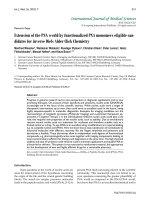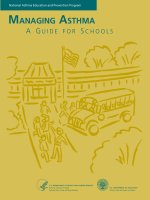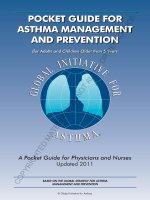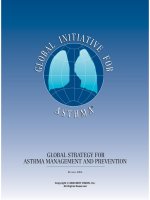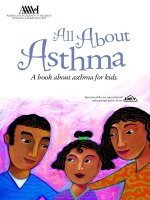Caffeine for asthma
Bạn đang xem bản rút gọn của tài liệu. Xem và tải ngay bản đầy đủ của tài liệu tại đây (898.07 KB, 18 trang )
Caffeine for asthma
Emma J Welsh1, Anna Bara2, Elizabeth Barley3, Christopher J Cates1
www.thecochranelibrary.com
Background
-Caffeine has been widely consumed throughout the world
for centuries.It is used for both non-medical and medical
purposes.It is ubiquitous,being found in coffee,tea,colaflavoured soft drinks and compound containing cocoa
-Caffeine has a variety of pharmacological effects; Caffeine
belongs to a group of chemicals called methylxanthines
+Methylxanthines is possibly due to their inhibition of
the enzyme phosphodiesterase which is a messenger
within the cell that regulates many functions including
the contraction and relaxation of smooth muscle.
+Methylxanthines are also competitive antagonists for
adenosine receptors. One of the effects of adenosine, a
chemical regulator, is that of bronchoconstriction
+ Methylxanthines
are known to be weak
bronchodilators and they also interact with respiratory
muscles to reduce respiratory muscle fatigue, along with the
bronchodilator drug theophylline.
- There are two major reasons why it is important to know if
caffeine is a bronchodilator
+The first is because it may be beneficial for asthmatics
to take caffeine in order to relieve the symtoms of asthma
+the second is because consuming caffeine may affect
the results of important tests that determine how bad
someone’s asthma is
OBJECTIVES
1. To identify all published randomised controlled trials
(RCT) of caffeine in the management of asthma.
2. To assess the methodological quality of these
randomised controlled trials.
3. To estimate the overall effect of caffeine upon lung
function and exhaled nitric oxide (FeNO).
4. To test whether there is a need to control for caffeine
consumption prior to lung function testing and testing
exhaled nitric oxide (FeNO).
5. To examine the need for further research into the effects
of caffeine in asthma.
METHODS
Criteria for considering studies for this review
Types of studies
- We included randomised trials (RCTs) only.
Types of participants
- We included adults (older than 18 years) with
previously documented with mild to moderate asthma
Types of interventions
- We included the following comparisons:
1. oral caffeine versus placebo; and
2. coffee versus decaffeinated coffee.
Primary outcomes
1. Lung function outcomes used were: forced expiratory
volume in one second (FEV1), maximum mid-expiratory flow
(FEF25-75) and specific airway conductance (Gaw/VL)
2. Exhaled nitric oxide concentration (FeNO)
Secondary outcomes
1. Forced vital capacity (FVC)
2. Maximal expiratory flow rates at 25% and 50% of vital
capacity (Vmax50 and Vmax25 respectively)
3. Exercise-induced bronchoconstriction
4. Pulse
5. Blood pressure
6. Symptoms
7. Serum caffeine levels
8. Side effects and adverse effects.
RESULTS
Interventions
-Caffeine and matched placebos were administered
orally (as solution = three studies, capsule = two
studies , decaffeinated coffee plus caffeine = one study,
caffeine versus decaffeinated coffee = one study)
-Two studies contributed to the ’low’ dose comparison:
Bukowskyj 1987(5mg/kg) & Colacone 1990 (5 mg/kg).
-Four studies contributed to the high’ dose comparison:
Crivelli 1986 (6 mg/kg), Duffy 1991 (10 mg/kg), Gong
1986 (7.2 mg/kg) and Kivity 1990 (7 mg/kg).
-one study,Taylor 2004,assessed drinking a cup of coffee
(prepared using a standard quantity-15 g-of either
caffeine-containing)versus decaffeinated coffee
Main results
- We included seven trials involving people with mild to
moderate asthma
- Six trials involving people showed that in comparison with
placebo, caffeine, even at a ’low dose’ (less than 5 mg/kg body
weight), appears to improve lung function for up to two
hours after consumption . FEV1 showed
a small
improvement up to two hours after caffeine ingestion
(standardised mean difference 0.72; 95% confidence interval
0.25 to 1.20) which translates into a 5% mean difference in
FEV1.
-However in two studies the mean differences in FEV1 were
12% and 18% after caffeine, FEF 25-75 also showed a small
improvement with caffeine and this was sustained up to four
hours
Subgroup analysis: ’low’ dose
-All lung function parameters tended to improve post
caffeine ingestion compared to placebo
+For FEV1, this effect was clear only at the ’short’ time
frame(up to 2 h)
+For FEF25-75, the difference was clear at all times
Subgroup analysis: ’high’ dose
-Lung function was found to improve following a ’high’
dose of caffeine compared to placebo for all measured
outcomes.
+For FEV1 and FEF25-75 ,this effect was clear only at the
’short’ time frame only.
+A clear improvement in Gaw/VL was also seen at the
’short’ time frame(up to 2 h)
-The papers differed in their reporting of serum caffeine levels
After a dose of caffeine (5 mg/kg)
+Bukowskyj 1987 reported a peak serum level of 8.7 (SD=
1.7)μg/mL one hour after ingestion.
+Colacone 1990 used the same dose and reported a mean (but
not peak) level of 5.4 (SD= 1.23) μg/mL at 1 hour 45 minutes
After a dose of cafeine(10 mg/kg)
+Duffy 1991 reported that peak serum levels of caffeine (mean
18.8; 95% CI 12.4 to 25.2 mg/L ) were observed 45 to 60 minutes
+Taylor 2004 reported that at 60 minutes, serum caffeine levels
were higher after ingesting regular caffeine-containing coffee than
after decaffeinated coffee at 60 minutes (3.9 versus 0.4 mg/mL
respectively).
Side effects and adverse effects
-Five of the studies commented on side effects,
including heart rate and blood pressure changes
+No side effects were reported after ’low’ doses of
caffeine.
+ After ingestion of a ’high’ dose of caffeine some
patients reported mild tremor (Kivity 1990),
nervousness and gastrointestinal upset (Gong 1986),
and some of them withdrew from the study because of
nervousness and agitation (Duffy 1991), which was
presumed to be due to the caffeine.
- Only one study (Gong 1986) reported significant
changes in heart rate (a decrease up to 9%) and blood
pressure (an increase up to 12%).
Outcomes relating to exhaled nitric oxide
-The impact of caffeine on FeNO was assessed in one
study of Taylor2004.This study reported no significant
difference in exhaled nitric oxide (data reported in the
text as non significant (P=0.38) and presented
graphically)
-Findings were not significantly different in subgroups
for those treated with inhaled steroids and those not
treated with steroids.
AUTHORS’CONCLUSIONS
Implications for practice
-Caffeine, even at ’low’ doses, has been found to improve
lung
function for at least four hours after ingestion.
-The most sensitive outcome FEF25-75 showed that
effects are sustained for over four hours post ingestion.
It is therefore recommended that patients be advised to
withhold caffeine for at least four hours prior to lung
function testing
- Caffeine does not appear to have a significant effect on
exhaled nitric oxide levels.
-This was not the purpose of trials examined in this review.
It is not known if tolerance to the bronchodilatory effects of
caffeine develops in habitual consumers
-The amount of dietary caffeine required and the true
benefit of dietary caffeine intake would be difficult to
calculate due to the varying levels of caffeine within
different foods and beverages.It appears that a substantial
intake of caffeinated products would be needed to achieve a
beneficial bronchodilatory effect and that possible
undesirable side effects may outweigh the benefits.
Implications for research
That caffeine has a bronchodilatory effect in asthma is clear from
existing research. Future studies could address the following.
1. Patients’ perception of the effect of caffeine on their asthma and
quality of life, as this has not been systematically studied.
2. The maximum length of time at which bronchodilation is
sustained, as this cannot be determined from existing trials.
3. Effects on patients with different levels of asthma severity, since
existing trials have only studied people with mild to moderate
asthma.
4. The response to caffeine of people with well-controlled asthmatics
on anti-inflammatory agents. Asthmatics using inhaled steroids
may be less responsive and this needs further evaluation.
5. Differences in the bronchodilator effects of caffeine between
habitual consumers and non-consumers.
6. Whether caffeine ingestion alters management decisions in
asthma (based on lung function measurements).
REFERENCES
References to studies included in this review
Bukowskyj 1987 {published data only}
Bukowskyj M, Nakatsu K. The bronchodilator effect of
caffeine in adult asthmatics. American Review of Respiratory
Disease 1987;135(1):173–5.
Colacone 1990 {published data only}
Colacone A, Bertolo L, Wolkove N, Cohen C, Kreisman
H. Effect of caffeine on histamine bronchoprovocation in
asthma. Thorax 1990;45(8):630–2.
Crivelli 1986 {published data only}
Crivelli M, Wahllander A, Jost G, Preisig R, Bachofen H.
Effect of dietary caffeine on airway reactivity in asthma.
Respiration 1986;50(4):258–64.
Duffy 1991 {published data only}
Duffy P, Phillips YY. Caffeine consumption decreases the
response to bronchoprovocation challenge with dry gas
hyperventilation. Chest 1991;99(6):1374–7.
Gong 1986 {published data only}
Gong H Jr, Simmons MS, Tashkin DP, Hui KK, Lee EY.
Bronchodilator effects of caffeine in coffee. A dose-response
study of asthmatic subjects. Chest 1986;89(3):335–42.
Kivity 1990 {published data only}
Kivity S, Aharon YB, Man A, Topilsky M. The effect of
caffeine on exercise-induced bronchoconstriction. Chest
1990;97(5):1083–5.
Taylor 2004 {published data only}
Taylor E, Smith AD, Herbison GP, Cowan JO, Taylor DR.
Effect of caffeine on exhaled nitric oxide measurements in
asthma [Abstract]. European Respiratory Journal 2003;22
(Suppl 45):P1165.
_ Taylor ES, Smith AD, Cowan JO, Herbison GP, Taylor
DR. Effect of caffeine ingestion on exhaled nitric oxide
measurements in patients with asthma. American Journal
of Respiratory and Critical Care Medicine 2004;169(9):
1019–21.
References to studies excluded from this review
Becker 1984 {published data only}
Becker AB, Simons KJ, Gillespie CA, Simons FE. The
bronchodilator effects and pharmacokinetics of caffeine in
asthma. New England Journal of Medicine 1984;310(12):
743–6.
Henderson 1993 {published data only}
Henderson JC, O’Connell F, Fuller RW. Decrease of
histamine induced bronchoconstriction by caffeine in mild
asthma. Thorax 1993;48(8):824–6.
Simmons 1983 {published data only}
Simmons M, Gong H, Tashkin DP, Hui K, Lee E.
Bronchodilator effects of coffee in asthmatics. Chest 1983;
84:332.
Thank you for your
attention and listening




